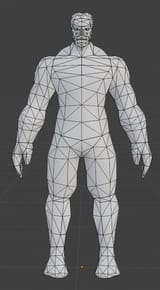Search Results
7/1/2025, 9:50:06 PM
>>714173069
It's extremely difficult. I've ripped the models, studied their textures and tried to replicate them. Here are some takeaways:
The character topology is extremely well done. Only about 1,000 triangles per character, but very well thought out. The pupils are actually just a plane floating above the eye area with an eye texture on them.
The textures are the most sophisticated and advanced part. Just extremely good painting, with really clever use of stretching certain parts of the texture out to save space. If you aren't an extremely high level painter, don't even bother with Warcraft style.
Then there is the lighting. WoW used per-vertex lighting, just like the PS2. So characters get lit by a basic ambient light and then a single directional light for the sun, but because the light is calculated per vertex it wraps smoothly and gently over the mesh giving a nice soft lighting that is impossible to replicate with modern per-pixel lighting.
They also use an interesting approach to that vertex lighting in the shader. So essentially they multiply the vertex color of every vertex (Whether it's painted on or from the directional light) using a pow function by some constant before mixing it back with the base color. In essence, what this does is a neutral grey vertex color will have zero effect on the base colors of a model. A bright white vertex color will make that area glow brightly and trigger bloom and a dark vertex color will create deep shadows. This is unlike a typical vertex color multiplied by base color approach most older games used in which the brightest color of a model would be the base color of their texture. This approach allows vertex lighting / colors to brighten and darken the model as well as trigger the familiar bloom we see in Vanilla Wow.
It's a ton of work to try to get that style and you need an engine built for that lighting model to really do it justice.
It's extremely difficult. I've ripped the models, studied their textures and tried to replicate them. Here are some takeaways:
The character topology is extremely well done. Only about 1,000 triangles per character, but very well thought out. The pupils are actually just a plane floating above the eye area with an eye texture on them.
The textures are the most sophisticated and advanced part. Just extremely good painting, with really clever use of stretching certain parts of the texture out to save space. If you aren't an extremely high level painter, don't even bother with Warcraft style.
Then there is the lighting. WoW used per-vertex lighting, just like the PS2. So characters get lit by a basic ambient light and then a single directional light for the sun, but because the light is calculated per vertex it wraps smoothly and gently over the mesh giving a nice soft lighting that is impossible to replicate with modern per-pixel lighting.
They also use an interesting approach to that vertex lighting in the shader. So essentially they multiply the vertex color of every vertex (Whether it's painted on or from the directional light) using a pow function by some constant before mixing it back with the base color. In essence, what this does is a neutral grey vertex color will have zero effect on the base colors of a model. A bright white vertex color will make that area glow brightly and trigger bloom and a dark vertex color will create deep shadows. This is unlike a typical vertex color multiplied by base color approach most older games used in which the brightest color of a model would be the base color of their texture. This approach allows vertex lighting / colors to brighten and darken the model as well as trigger the familiar bloom we see in Vanilla Wow.
It's a ton of work to try to get that style and you need an engine built for that lighting model to really do it justice.
Page 1
